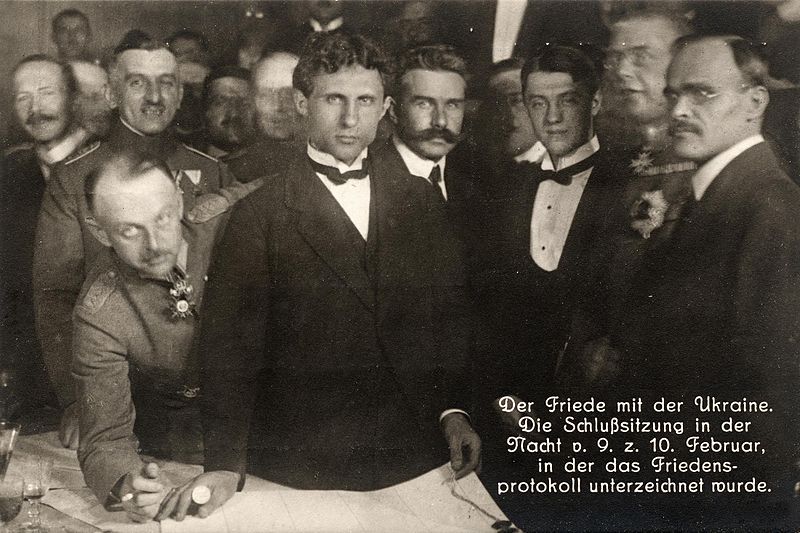<Back to Index>
- Chairman of the Council of People's Ministers of Ukrainian People's Republic Serhiy Ostapenko, 1881
PAGE SPONSOR

Serhiy Ostapenko (November 1881 - 1937) was an economist, statesman and political activist of Ukraine. In the beginning of 1919 he directed the Council of People's Ministers of Ukrainian People's Republic (prime minister).
Ostapenko was born in the town of Troyaniv near Zhytomyr in November 1881. Today it is a village of Zhytomyr Raion, Zhytomyr Oblast. Ostapenko was born into a family of a poor peasants and his father had another job as a freight transporter. From 1893 to 1897 Ostapenko attended the local elementary school after which he enrolled into an agrarian middle school in Bilokrynytsia of Kremenets uyezd (today Kremenets Raion of Ternopil Oblast).
In 1904 he started to work as a teacher in a two - grade school of Turiysk of Kovel uyezd. In 1905 Ostapenko was arrested being a member of the Ukrainian Socialist Revolutionary Party. He spent the next three years in jail for political reasons as he claimed. After his release, Ostapenko had some trouble in finding employment. He graduated from the Vladimir cadet corps by taking final tests in 1909 and the same year enrolled into the Economic school of Kiev Commercial Institute. Upon his graduation in 1913 Ostapenko was sent to Germany for additional studies in economics.
In 1913 he returned to Ukraine where he found a job as the head of the Bureau of Statistics in Balta uyezd of Podolia Governorate. In 1914 Ostapenko was transferred to Kharkov where he headed the Bureau of Statistics for the Mining Industry of Sloboda Ukraine. Later he returned to Kiev where he worked as a private docent in the Kiev Commercial Institute until 1917.
In January 1918 Ostapenko was included as an economic adviser to the Ukrainian economic commission of Vsevolod Holubovych for the negotiations in Brest - Litovsk (Treaty of Brest - Litovsk (Ukraine - Central Powers)). On March 14, 1918 Ostapenko was included in the trade commission of Mykola Porsh for the goods exchange with the Central Powers and responsible to the Council of People's Ministers.
During the era of the Ukrainian State Ostapenko was included to the Serhiy Shelukhin's economic commission of the Ukrainian peace delegation during the negotiations with the delegation of the Soviet Russia in Kiev. These negotiations took place from May 23 through October 7, 1918. Concurrently with it Ostapenko read lectures of political economy, economical geography, and others, for various schools in the city of Kiev.
After the Directorate of Ukraine forced Pavlo Skoropadsky to emigrate, Ostapenko, being the member of the Ukrainian SR party, was elected to the socialist government of Volodymyr Chekhivsky as the minister of trade and industry. In February 1919 when the government of Ukraine had to relocate out of Kiev to Vinnytsia with the advancing Bolshevik forces, Ostapenko discontinued his membership with the Ukrainian SRs. After the resignation of several ministers from the government he was performing the duties of the minister of political agitation and propaganda. On February 6, 1919 Ostapenko participated as the representative of the Ukrainian government in the negotiations with the Chief of staff of the French military forces Colonel Freidenberg (Entente intervention) at the railroad station of Birzula, near Odessa. The Ukrainians were requesting from the representatives of the Entente a recognition of the sovereignty of Ukraine, allowing it to participate at the Paris peace conference, among several other important functions. After the negotiations brought no results, the government of Chekhivsky resigned.
The Directorate of Ukraine requested Ostapenko, who was inclined to find common ground with the members of the Entente, to form another government. His government was composed mostly out of more liberal - democratic representatives, but as the government did not bring any real results in the short period of time, it was replaced by the government of more socially oriented Borys Martos. No place for Ostapenko was allocated in the new government and he moved for a couple of months to Galicia.
After some successes at the Bolshevik front and the liberation of Podolia, he moved to Kamyanets - Podilsky that since June 1919 served as the temporary administrative center of the Ukrainian People's Republic until the end of 1919. Still unable to find a job Ostapenko applied to the Kamyanets - Podilsky State University that was hiring numerous professors and private docents in various fields.
On July 18, 1919 the minister of education Anton Krushelnytsky accepted his application by the reference of the University's first rector Ivan Ohienko. Ostapenko became a private docent at the Department of Statistics of the University's Jurisprudence School and started his work in October 1919. On November 5, 1919 the council of the University's professors asked him to lecture in political economy beside his classes of statistics. On February 25, 1920 Ostapenko was confirmed as the permanent docent of the Department of Political Economy and Statistics. In May 1920 the guberniya administration published his books The course of statistics and demographics of 3,500 copies and The important characteristics of the Ukrainian ethnicity in comparison to other ethnics of 1,500.
By the end of 1920 Ostapenko relocated to Kiev. In May 1921 the Supreme Extraordinary Tribunal began the hearing of the affair of Ukrainian SRs on which Ostapenko was invited as a witness. However by the proposition of Dmitry Manuilsky he was placed among the ones under trail. Ostapenko pleaded not guilty and was given five years of service in correctional labor camps. Later unexpectedly the sentence was changed and he was forced to work by specialty instead of katorga, due to his value as a scientific force. His fate afterwards is not known. There are speculations that in 1931 he was arrested by the NKVD and perished in the labor camps (according to the Encyclopedia of Ukraine) sometime in 1937.